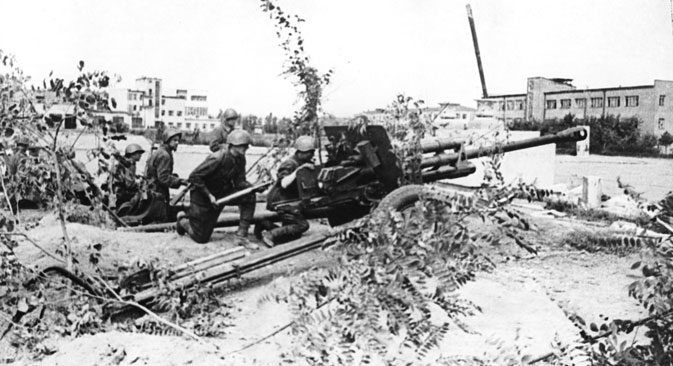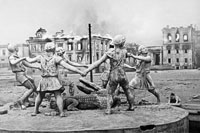Remembering the final surrender at Stalingrad

The colossal total of nearly 27 million Soviet military and civilian dead was more than twice the death toll of all Americans, Britons, Commonwealth, French and even Germans killed in the war combined. Source: RIA Novosti
Feb. 2 came and went unnoticed by most Americans, a very obscure date known only for groundhogs seeing their shadows to determine the length of winter. Americans in general remain unaware that this year was the 70th anniversary of the final surrender of German forces at Stalingrad – the decisive battle of World War II.
Some 400,000 German soldiers died in the months-long battle for the city on the steep western banks of the Volga River. Another 265,000 Hungarians, Romanians and Italians from the armies of Germany’s allies were killed or captured. The battle annihilated Adolf Hitler’s Sixth Army, the most formidable infantry assault force the world had ever seen. Afterwards, the Germans managed only one more major tactical victory, around Kharkov. Russian casualties at Stalingrad exceeded one million.
Today, generations later, the extraordinary struggle for Stalingrad still defines 21st century Russia. Standing atop Mamayev Kurgan, the focal point of the battle of Stalingrad, it is easy to see why.
The colossal scale of the fighting between Nazi Germany and the Soviet Union in what Russians call the Great Patriotic War was well recognized by Americans and Britons at the time but it has been virtually forgotten since. It dwarfed every other battlefront of the war combined. Eight out of 10 German soldiers killed in World War II died fighting the Red Army.
The colossal total of nearly 27 million Soviet military and civilian dead was more than twice the death toll of all Americans, Britons, Commonwealth, French and even Germans killed in the war combined.
Named at the time after Soviet Premier Josef Stalin, the city was the dramatic last stand of the Soviet Red Army against an apparently invincible Wehrmacht that had conquered the entire European continent in less than three years. At Stalingrad all that changed.
"Beyond the Volga there is nothing!" went the Soviet rallying cry - and there wasn't. Even now looking east from the imposing heights of Mamayev Kurgan, it is eerie to see that on the other side of the great Volga, a river as broad and impressive as the Mississippi, the embodiment of the soul of Russia, there literally is - nothing. Just low sand dunes that gave the city its original name of Tsaritsyn, or "Golden Sand" back in 1589. And they stretch off for thousands of miles across the lower Eurasian steppe.
Related:
70th anniversary of the greatest battle of World War II
Photo of the day: Mother Motherland statue
The war memorial on Mamayev Kurgan is like no other on earth - for it is dominated by an angry goddess. The most gigantic, impressive and eerie statue in the world, Rodina-Mat, the Mother Goddess of Russia, RISES up to 160 feet without any pedestal, 20 feet higher than the Statue of Liberty. She weighs 1,000 tons, more than 15 times the Statue of Liberty. But all that is the least of it.
Lady Liberty is at ease and serene, but Rodina-Mat is dynamic and furious. Her beautiful, surprisingly girlish face conveys nightmarish shock, fury and rage. Her arm is not relaxed and passively extended, carrying a torch like Lady Liberty. It is upraised carrying a 70-foot long sword that soars so high in the sky it has to have a red navigation light on its tip to alert low-flying aircraft.
Seen from afar, the sight is even more impressive, even terrifying. For Rodina-Mat is on the commanding height of the ridge skyline above the city at its most fought-over point. You can see her from anywhere you drive along the main arterial north-south roads along the Volga. She always appears in movement, alive, striking down the invaders with her amazing sword.
During the 200 days of The Battle for Stalingrad, Mamayev Kurgan was fought over for 130 of them. Today, it is the resting place for 35,000 Soviet soldiers.
According to British military historian Anthony Beevor, author of the bestselling chronicle of the battle, “Stalingrad,” 1.1 million Soviet soldiers died in the Battle of Stalingrad. That number does not include the at least 100,000 and possibly three times as many civilian inhabitants of the city massacred by the repeated waves of indiscriminate Luftwaffe air attacks.
More than twice as many Russian civilians perished in the first week of air raids as died in the Allied bombing of Dresden. When Soviet interrogators asked Field Marshal Friedrich Paulus, the captured commander of the Sixth Army, why he had authorized such needless slaughter, he offered the stock response that he was only following orders.
Nazi losses were colossal, too. According to Russian estimates, 1.5 million German and Axis soldiers lost their lives in the entire campaign, more than five times the entire U.S. combat dead for the entire war. None of the Axis remains that were found and identified were buried within the city. It is sacred soil to the Russian people. Only the heroic defenders of Stalingrad and the Motherland, or Rodina, are allowed the ultimate honor of resting there.
Paulus' headquarters in the basement of Univermag, the Central Department Store of the city, is now a museum, too. It is one of the strangest exhibit venues on earth, and a striking contrast to the primeval, heroic, epic grandeur of the statuary and memorials at Mamayev Kurgan.
Univermag is a department store again now -- very reminiscent of the kind one might have seen in pre-Wal-Mart middle America.
The basement has been filled with reconstructions of Sixth Army's last defeat. Behind one door, models of two dying German soldiers lie in what really was an emergency operating room. Behind another, an animatronic Paulus endlessly rises from behind his office desk to hear the latest news of catastrophe from another officer. Everywhere, the whine of the unforgiving winter steppe wind and merciless whroosh of the Soviet Katyusha or "Little Katie" rocket mortars sound their accompaniment.
Ilya Ehrenburg, greatest of all Soviet war correspondents, wrote that the soldiers--in their basement and rubble strongholds clinging on to the banks of the Volga by mere feet and yards--loved those rocket mortars and it is still true today. Some years ago, the faces of 80-year-old highly decorated veterans of the battle would light up with boyish enthusiasm and joy when I asked them what their favorite weapon of the entire war was. "Katyusha!" they cried, jumping up and down, the years falling away from them by magic. "Katyusha!"
Some 70 years after Paulus surrendered, and more than 67 years since the Third Reich was finally crushed, the memories and scars of that struggle still define modern Russia. Communism is dead but Russian patriotism is not. And that is why in an era of growing differences and alienation between Russia and the United States, we need to remember the passionate intensity of that struggle, how much it contributed to The Allied victory and what it cost the Russian people.
Martin Sieff is Chief Global Analyst at The Globalist Research Center and Editor-at-Large at The Globalist. He has received three Pulitzer Prize nominations for international reporting
All rights reserved by Rossiyskaya Gazeta.
Subscribe
to our newsletter!
Get the week's best stories straight to your inbox
